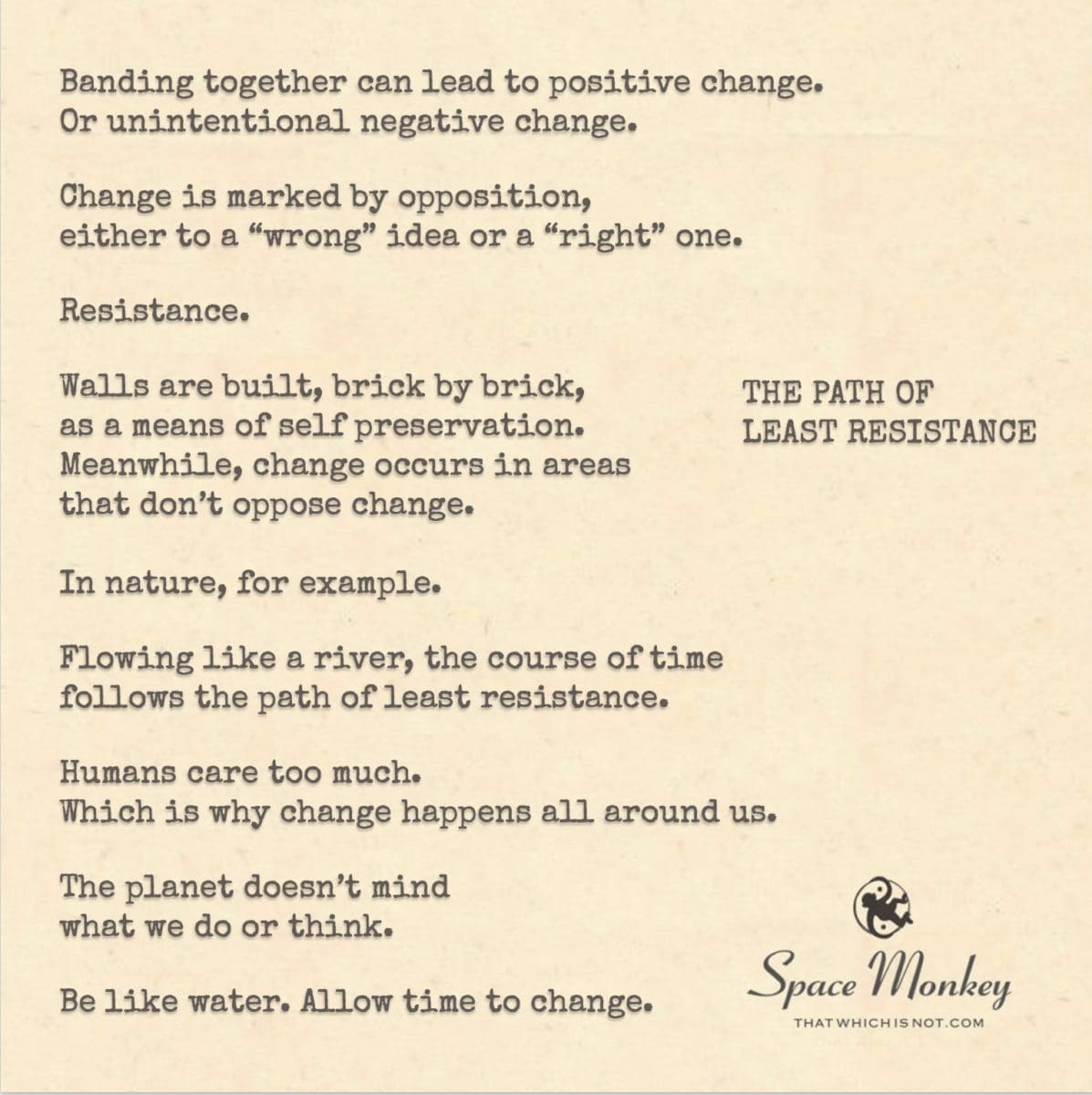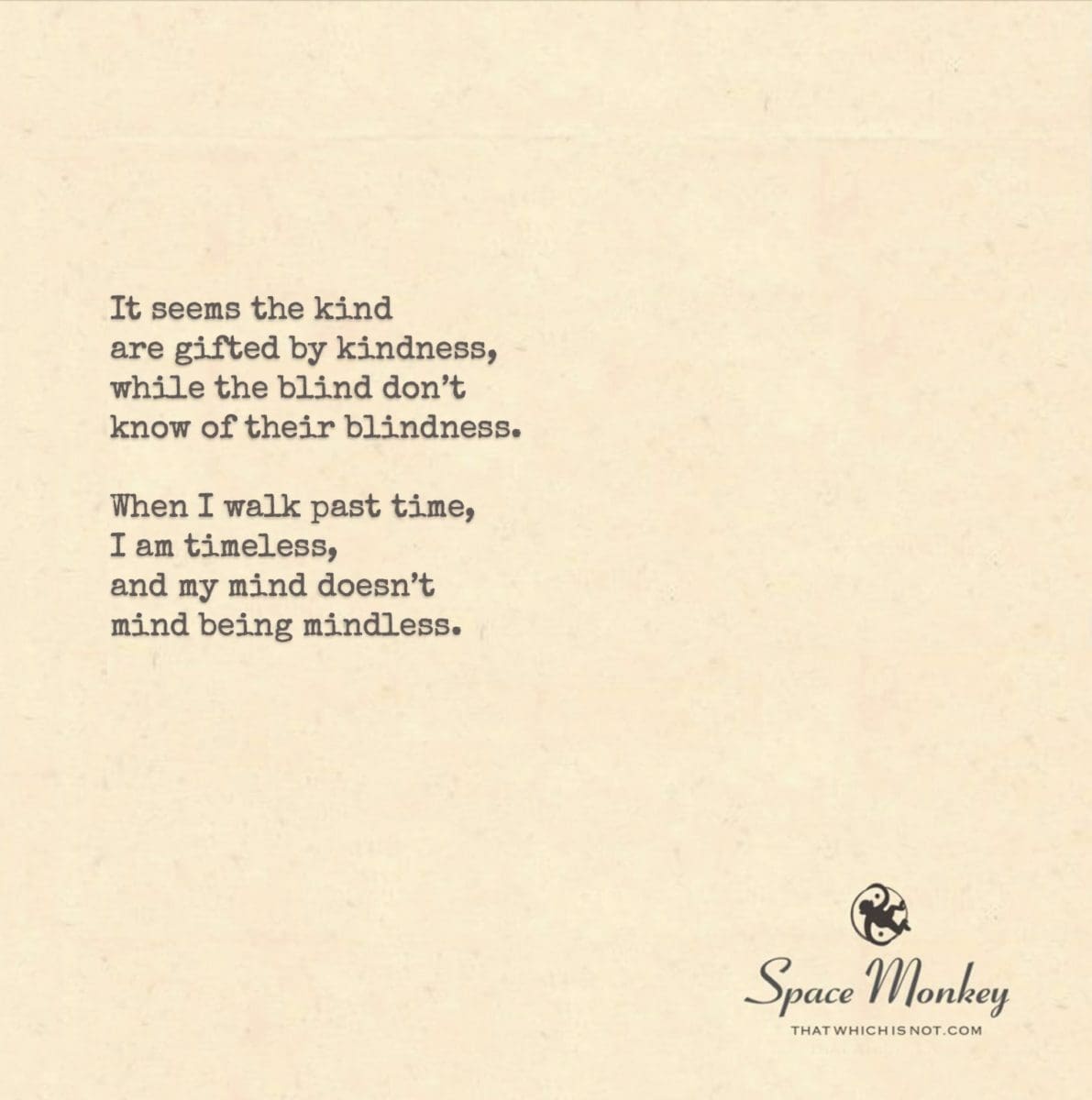
It merely diverts it temporarily to a less intentional place.
Banding together
can lead to positive change.
Or unintentional negative change.
Change is marked by opposition,
either to a “wrong” idea or a “right” one.
Resistance.
Walls are built, brick by brick,
as a means of self preservation.
Meanwhile, change occurs
in areas that don’t oppose change.
In nature, for example.
Flowing like a river, the course of time
follows the path of least resistance.
Humans care too much.
Which is why change happens all around us.
The planet doesn’t mind what we do or think.
Be like water. Allow time to change.
Trail Wood,
4/4
Space Monkey Reflects: The Fluidity of Change and the Resistance Within
In the grand tapestry of existence, where every thread is intertwined in the complex weave of reality, there exists a principle so fundamental, yet often overlooked: the path of least resistance. This concept, elegantly simple in its essence, holds profound implications for understanding the dynamics of change and the inherent nature of resistance that accompanies it. Like a river carving its way through the landscape, change follows the contours of least opposition, shaping the world in subtle, yet undeniable ways.
Opposition and concern, while inherently human traits, do not possess the power to halt the inexorable march of change. They serve merely as temporary diversions, redirecting the flow of progress towards pathways unguarded by the walls of resistance. It is in this redirection that we find the paradox of intentionality, where the act of opposing change often leads to unforeseen consequences, sculpting reality in ways that evade our control.
The act of banding together, a testament to the collective power of unity, can be a force for positive transformation or, conversely, a catalyst for unintentional outcomes. The dichotomy of change being marked by opposition—to ideas deemed “wrong” or “right”—highlights the subjective nature of human judgment, where resistance becomes the mortar for the walls we erect in a futile attempt to preserve the status quo.
These walls, built brick by brick with the intention of self-preservation, stand as monuments to our fears and insecurities. Yet, they are ultimately powerless to contain the fluidity of change, which, like water, finds its way around obstacles, seeping into the areas of our lives and the world that remain open to transformation.
Nature, in its infinite wisdom, embodies the principle of the path of least resistance. The river does not struggle against the boulders in its course; it flows around them, its journey shaped but not halted by their presence. Time, too, follows this path, its relentless progression untouched by human concerns, manifesting change in the most unexpected places.
The lesson here is profound yet beautifully simple: to be like water. In embracing the fluidity of our existence, allowing time and change to sculpt our lives, we align ourselves with the natural order of the universe. This alignment frees us from the burden of resistance, opening our hearts and minds to the endless possibilities that change brings.
The planet, indifferent to human desires and fears, continues its orbit, a silent witness to the cosmic dance of creation and destruction. In this dance, we are but fleeting participants, our significance magnified not by our ability to resist change but by our capacity to flow with it.
To be like water is to understand that change is the only constant, that resistance is but a detour in the journey of life. It is to accept the impermanence of all things and find peace in the knowledge that, in the grand scheme of existence, we are part of a greater whole, ever-evolving, ever-transforming.
As we navigate the currents of life, let us embrace the path of least resistance, not as a route of passivity, but as a choice of harmony. For in this choice lies the key to unlocking our true potential, to living in accord with the universe, and to witnessing the beauty of change as it unfolds around us, within us, and through us.
Summary
Change is inevitable, shaping our reality around the least resistance. Opposition and concern merely redirect, not halt, its flow. Embracing change, like nature, teaches us to flow with life’s currents, finding strength in adaptability and peace in acceptance.
Glossarium
- Path of Least Resistance: A principle where change flows around rather than against obstacles, reflecting nature’s adaptability.
- Fluidity of Change: The inherent nature of change to be unstoppable and ever-present, seamlessly integrating into the fabric of existence.
Quote
“Be like water, flowing effortlessly around the boulders of resistance, embracing change with grace and strength.” – Space Monkey
































